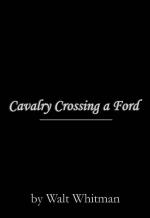|
This section contains 437 words (approx. 2 pages at 400 words per page) |

|
Cavalry Crossing a Ford Summary & Study Guide Description
Cavalry Crossing a Ford Summary & Study Guide includes comprehensive information and analysis to help you understand the book. This study guide contains the following sections:
This detailed literature summary also contains Bibliography on Cavalry Crossing a Ford by Walt Whitman.
"Cavalry Crossing a Ford" was first published in 1865 in Drum Taps, a collection of poems Whitman wrote during the Civil War, and was later incorporated into Leaves of Grass. The specific inspiration for this poem is not known, but Whitman did work as a nurse during the Civil War and may well have written this piece upon witnessing a cavalry troop crossing a river. Unlike the majority of poems Whitman penned during the Civil War, "Cavalry Crossing a Ford" does not use the firstperson "I" to put the scene it describes into a particular context. Instead of filtering the scene through a first-person narrator, the speaker of the poem journalistically presents a series of images and entreats the reader to "behold" the scene as though he or she were the first-person observer. It is as if the speaker imagined his reader standing beside him and seeing exactly what he sees as he sees it.
Perhaps the most interesting facet of the poem concerns the perspective from which the scene is observed and presented. The panoramic quality of the images suggests that the observer (implicitly, the reader) is viewing the scene from some distance. The whole of the cavalry troop is seen at once, as though the reader were looking down from some great height. However, from this vantage the reader is ultimately unable to distinguish the particulars of the scene from the larger whole. Each individual soldier becomes merely part of the "they" that makes up the entire cavalry, and no particular individual is given special attention or distinction in the scene. The climax of the poem then comes in the last line, when suddenly the focus is on the "guidon flags." While the reader has thus far been unable to distinguish the individuals who make up the cavalry troop, now the relatively small flags and even the particular colors they contain are described in detail. Such flags ultimately suggest political allegiance and serve to distinguish the two opposing forces of the battle. In turning attention to the flags, the poem presents a specific manner of viewing the world, one in which individual human beings are no more than their political allegiances. This mindset was no doubt prevalent during the Civil War, a time when people were compelled to choose sides, and self-preservation depended upon distinguishing one's comrades from one's enemies. That the "guidon flags" are seen to "flutter gayly" implies that the approaching cavalry troop poses no threat. The poem ends here, leaving the reader with the impression that attention to the scene is no longer necessary; the speaker has conveyed what is important.
Read more from the Study Guide
|
This section contains 437 words (approx. 2 pages at 400 words per page) |

|



